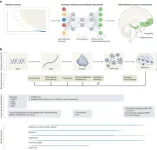(Press-News.org) Patrick Sullivan, MD, FRANZCP, the Yeargan Distinguished Professor of Psychiatry and Genetics at the UNC School of Medicine, and researchers at the Karolinska Institutet in Stockholm, Sweden, have developed a comprehensive outline of the genetics of schizophrenia. The review was published in Nature Reviews Neuroscience.
Schizophrenia is a neuropsychiatric disorder featuring recurrent episodes of psychosis – such as hallucinations, delusions, and disorganized thinking – with many patients developing apathy, social withdrawal, and poor emotional control as a result.
Because schizophrenia has been known to run in families for centuries, researchers have turned to genetic testing and analyses to identify risk factors for the condition. Recent genomic research on schizophrenia has identified nearly 300 common genetic variants and over 20 rare variants as significant risk factors for the disorder.
These discoveries have emerged from extensive genome-wide association studies, whole-exome sequencing, and other analyses. Simultaneously, studies of the functional organization of the brain have shed light on the intricate cellular composition and interconnections of the brain in both neurotypical individuals and those with schizophrenia.
These findings reveal a surprising complexity in the mechanisms underlying schizophrenia, emphasizing the role of multiple genes rather than single-gene causation. This “polygenicity” highlights a mechanism that remains challenging to fully understand due to the lack of robust theoretical frameworks and experimental tools. Sullivan and colleagues reviewed these issues and provided ideas for a path forward in the Nature Reviews Neuroscience article.
However, Sullivan and colleagues stress that environmental factors (including lifestyle, drug use, poverty, stress, and complications at birth) are also relevant in addition to genomic risk. Although these factors are more difficult to study compared to the genome, this genetic information is important for researchers to consider because some environmental factors are modifiable.
“The findings to date resoundingly indicate complexity,” wrote Sullivan, who is also director of the UNC Center for Psychiatric Genomics and the UNC Suicide Prevention Institute. “Rather than being a deterrent to future research, this knowledge underscores the importance of accepting schizophrenia as a genetic and environmental enigma and scaling our research accordingly in our efforts improve the lives of those impacted by schizophrenia.”
END
What researchers know about the genetic complexity of schizophrenia, to date
2024-08-02
ELSE PRESS RELEASES FROM THIS DATE:
New study highlights scale and impact of long COVID
2024-08-02
In a new review paper, researchers from the Universities of Arizona, Oxford and Leeds analyzed dozens of previous studies into long COVID to examine the number and range of people affected, the underlying mechanisms of disease, the many symptoms that patients develop, and current and future treatments.
Long COVID, also known as Post-COVID-19 condition, is generally defined as symptoms persisting for three months or more after acute COVID-19. The condition can affect and damage many organ systems, leading to severe ...
How the rising earth in Antarctica will impact future sea level rise
2024-08-02
COLUMBUS, Ohio – The rising earth beneath the Antarctic Ice Sheet will likely become a major factor in future sea level rise, a new study suggests.
Despite feeling like a stationary mass, most solid ground is undergoing a process of deformation, sinking and rising in response to many environmental factors. In Antarctica, melting glacial ice means less weight on the bedrock below, allowing it to rise. How the rising earth interacts with the overlying ice sheet to affect sea level rise is not well-studied, said Terry Wilson, co-author of the study and a senior research scientist at the Byrd Polar and Climate Research Center ...
Research spotlight: Uncovering the links between sleep struggles, substance abuse and suicidal thoughts in teens with depression
2024-08-02
Rebecca Robbins, PhD, of the Division of Sleep and Circadian Disorders at Brigham and Women’s Hospital, is the senior author of a paper published in Psychiatry Research, “Exploring sleep difficulties, alcohol, illicit drugs, and suicidal ideation among adolescents with a history of depression.”
How would you summarize your study for a lay audience?
Suicide is one of the leading causes of death for adolescents in the U.S. We know, due to previous research, that difficulty falling asleep or waking up too early as well as abuse of prescription ...
Boosting children’s voices could help to relieve significant backlogs in the family court, study says
2024-08-02
Giving children a right to be heard and taken seriously when parents separate could help couples reach sustainable child arrangements and relieve significant backlogs in the family court, avoiding unnecessary financial and emotional costs, a new study says.
Mediation, court and legal processes should provide a forum for young people’s views on post-separation arrangements being considered for them to be aired independently and factored in wherever appropriate. Giving them more agency about decisions which affect their lives and futures will help families make more effective ...
Study yields new insights into the link between global warming and rising sea levels
2024-08-02
A McGill-led study suggests that Earth's natural forces could substantially reduce Antarctica’s impact on rising sea levels, but only if carbon emissions are swiftly reduced in the coming decades. By the same token, if emissions continue on the current trajectory, Antarctic ice loss could lead to more future sea level rise than previously thought.
The finding is significant because the Antarctic Ice Sheet is the largest ice mass on Earth, and the biggest uncertainty in predicting future sea levels is how this ice will respond to climate change.
“With nearly 700 million people living in coastal areas and the potential ...
Controlling thickness in fruit fly hearts reveals new pathway for heart disease
2024-08-02
Scientists at Sanford Burnham Prebys and Salk Institute for Biological Studies have uncovered a new role for a protein known for its role in the brain helping control feelings of hunger or satiety, as well as in the liver to aid the body in maintaining a balance of energy during fasting. The new study shows that this protein also supports the maintenance of heart structure and function, but when it is overactive it causes thickening of the heart muscle, which is associated with heart disease.
Excessive thickening of the heart muscle—known as cardiac hypertrophy—is often ...
Improving cat food flavors with the help of feline taste-testers
2024-08-02
Cats are notoriously picky eaters. But what if we could design their foods around flavors that they’re scientifically proven to enjoy? Researchers publishing in ACS’ Journal of Agricultural and Food Chemistry used a panel of feline taste-testers to identify favored flavor compounds in a series of chicken-liver-based sprays. The cats particularly enjoyed the sprays that contained more free amino acids, which gave their kibble more savory and fatty flavors.
Cats have a more acute sense of smell than humans, and the aroma of their food plays a big role in whether they’ll eat or snub what their owner serves for dinner. Feline palates are also more sensitive to umami ...
Subclinical hypothyroidism in early pregnancy associated with more than quadrupled risk of reduced thyroid function within 5 years of delivery
2024-08-02
A new study has shown that subclinical hypothyroidism diagnosed before 21 weeks of pregnancy is associated with more than fourfold higher rates of overt hypothyroidism or thyroid replacement therapy within 5 years of delivery. The study is published in the peer-reviewed journal Thyroid®, the official journal of the American Thyroid Association® (ATA®).
Subclinical hypothyroidism, or a change in the levels of thyroid-stimulating hormone (TSH) that isn’t severe enough to cause symptoms, ...
BNP-Track algorithm offers a clearer picture of biomolecules in motion
2024-08-02
It’s about to get easier to catch and analyze a high-quality image of fast-moving molecules. Assistant Professor Ioannis Sgouralis, Department of Mathematics, and colleagues have developed an algorithm that adds a new level to microscopy: super-resolution in motion.
The cutting-edge advancement of super-resolution microscopy was recognized with the 2014 Nobel Prize in Chemistry for its groundbreaking innovation. It improves optical microscopy with a suite of techniques that overcome the inherent limitations set by the physics of light. The high-frequency oscillations of light waves escape detection ...
Not the day after tomorrow: Why we can't predict the timing of climate tipping points
2024-08-02
A new study published in Science Advances reveals that uncertainties are currently too large to accurately predict exact tipping times for critical Earth system components like the Atlantic Meridional Overturning Circulation (AMOC), polar ice sheets, or tropical rainforests. These tipping events, which might unfold in response to human-caused global warming, are characterized by rapid, irreversible climate changes with potentially catastrophic consequences. However, as the new study shows, predicting when these events will occur is more difficult than previously thought.
Climate scientists from the Technical University of Munich (TUM) and ...




